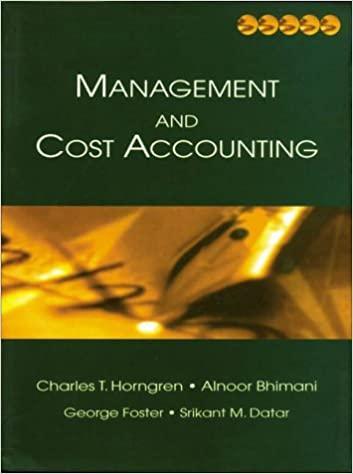Question
An ACCOUNTING RATIO is a number that shows the relationship between two elements on a firms financial statements. Like the individual elements on the financial
An ACCOUNTING RATIO is a number that shows the relationship between two elements on a firms financial statements. Like the individual elements on the financial statements, these ratios can be compared with those of competitors, with industry averages, and with the firms ratios from previous accounting periods.
Since there are many accounts shown on the businesss financial statements, there can be many ratios. The four most popular types of ACCOUNTING RATIOS are LIQUIDITY RATIOS, PROFITABILITY RATIOS, ACTIVITY RATIOS and LEVERAGE RATIOS. Depending upon your perspective, you would work a certain ratio in order to help you make an important decision or to answer an important question, i.e., as the business owner, is your money in the right place, should you extend credit to this business, are there areas in the business that deserve your managerial attention, etc. Nothing can eliminate risk in todays business environment - but working and interpreting ratios can help reduce risk.
Based upon the financial statements for Harvest Gold on pages 441 and 444, the six most common ACCOUNTING RATIOS are below. (BS) means that the account totals are found on the Balance Sheet and (IS) means that the account totals are found on the Income Statement.
LIQUIDITY RATIOS
Liquidity ratios are used by current and future suppliers when a firm requests credit. They give insight into a companys ability to meet their short-term debt obligations.
CURRENT RATIO
Current Assets (BS) 600,000 $2.08 to $1.00
Current Liabilities (BS) 288,000
Interpretation: For each dollar of current debt, this firm has $2.08 of current assets with which to pay it The
average current ratio for all businesses is 2.0, but it varies greatly from industry to industry. A high current ratio
indicates that a firm can pay its current liabilities. A low current ratio can be improved by repaying current liabilities, by reducing dividend payments to stockholders to increase the firms cash balance, or by obtaining
additional cash from investors.
QUICK RATIO or ACID-TEST RATIO
Liquid Current Assets (BS) 15,000 + 200,000 + 50,000 265,000 $ .92 to $1.00
Current Liabilities (BS) 288,000 288,000
Interpretation: For each dollar of current debt, this firm has $ .92 of liquid current assets with which to pay it.
The Quick Ratio takes a closer look at the companys Current Assets than the Current Ratio. It considers only the most liquid Current Assets. The term liquid deals with the conversion of the asset to cash. An Inventory Liquidation Sale is an attempt to sell the merchandise inventory in order to generate cash. Current Assets are listed on the Balance Sheet in the order of liquidity. Since cash is the most liquid asset, it will always be listed first.
PROFITABILITY RATIOS
Profitability ratios are used by managers, owners and prospective owners to see if the business is profitable and will be a good investment.
RETURN ON SALES
Net Income (IS) 49,000 .07 to $1.00
Net Sales (IS) 700,000
Interpretation: For each $1.00 of net sales the company made .07 profit A higher return on sales is better than a low one. Today, the average return on sales for all business firms is between 4 and 5 percent. A low return on sales can be increased by reducing expenses, by increasing sales, or both.
RETURN ON EQUITY
Net Income (IS) 49,000 .23 to $1.00
Owners Equity (BS) 213,000
Interpretation: For each $1.00 of owners equity, the company made .23 profit. The business owners have many choices as to where to put their money. If they had put their money into a savings account at their local bank it would have returned less than .01 on each dollar. As always, risk has to be considered. There is no risk associated with most bank accounts as they are insured by the FDIC. Even though the owners received .23 return on their investment during this accounting period there is no guarantee that they will receive anything on their investment next year.
ACTIVITY RATIOS
Activity ratios focus on a specific action in the business, such as the speed with which it sells and restocks its inventory and the speed with which it collects its accounts receivables.
INVENTORY TURN-OVER RATIO
Cost of Goods Sold (IS) 410,000 410,000 1.9 times/year
Average Inventory (IS) (200,000 + 230,000) / 2 215,000
Interpretation: The firm completely sells the value of their inventory 1.9 times per year, or every 192 days. The average inventory turnover for all firms is about nine times a year, but turnover rates vary widely from industry to industry. The quickest way to improve inventory turnover is to order merchandise in smaller quantities at more frequent intervals.
LEVERAGE RATIOS
Leverage ratios focus on a firms total debt. They are used by providers of long-term debt, such as mortgage brokers. They give insight into the firms ability to meet all of its obligations.
DEBT TO EQUITY RATIO
Total Liabilities (BS) 613,000 2.88 to $1.00
Owners Equity (BS) 213,000
Interpretation: For each $1.00 invested by the owners of the firm, the firm has borrowed, and owes, 2.88. This ratio compares the claims against the assets by outsiders, in the form of liabilities, and the owners, or the insiders. The lower the Debt-to- Equity ratio, the better. A Debt-to-Equity ratio greater than $1.00 like this one would mean that the business is owned more by the creditors than the owners themselves.
Step by Step Solution
There are 3 Steps involved in it
Step: 1

Get Instant Access to Expert-Tailored Solutions
See step-by-step solutions with expert insights and AI powered tools for academic success
Step: 2

Step: 3

Ace Your Homework with AI
Get the answers you need in no time with our AI-driven, step-by-step assistance
Get Started


